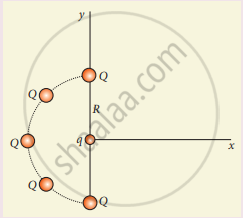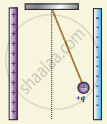Advertisements
Advertisements
प्रश्न
The total number of electrons in the human body is typically in the order of 1028. Suppose, due to some reason, you and your friend lost 1% of this number of electrons. Calculate the electrostatic force between you and your friend separated at a distance of lm. Compare this with your weight. Assume the mass of each person is 60kg and use point charge approximation.
उत्तर
Number of electrons in the human body = 1028
Number of electrons in me and my friend after lost of 1% = 1028 x 1%
`= 10^28 xx 1/100`
n = 1026 electrons
Separation distance d = 1 m
Charge of each person q = 1026 x 1.6 x 10-19
q = 1.6 x 107 C
Electrostatic force, F = `1/(4 pi epsilon_0) = ("q"_1"q"_2)/"r"^2 = (9 xx 10^9 xx 1.6 xx 10^7 xx 1.6 xx 10^7)/1^2`
F = 2.304 x 1024N
Mass of the person, M = 60 kg
Acceleration due to gravity, g = 9.8 ms-2
Weight (W) = mg
= 60 x 9.8
W = 588 N
Electrostatic force is equal to 3.92 x 1021 times of weight of the person.
APPEARS IN
संबंधित प्रश्न
Which charge configuration produces a uniform electric field?
Rank the electrostatic potential energies for the given system of charges in increasing order.

An electric field `vec"E" = 10 xx hat"i"` exists in a certain region of space. Then the potential difference V = Vo – VA, where Vo is the potential at the origin and VA is the potential at x = 2 m is:
A thin conducting spherical shell of radius R has a charge Q which is uniformly distributed on its surface. The correct plot for electrostatic potential due to this spherical shell is
Two points A and B are maintained at a potential of 7 V and -4 V respectively. The work done in moving 50 electrons from A to B is ______.
Define electrostatic potential.
What is an equipotential surface?
Obtain an expression for potential energy due to a collection of three point charges which are separated by finite distances.
Five identical charges Q are placed equidistant on a semicircle as shown in the figure. Another point charge q is kept at the center of the circle of radius R. Calculate the electrostatic force experienced by the charge q.

Draw the free body diagram for the following charges as shown in the following figure.

